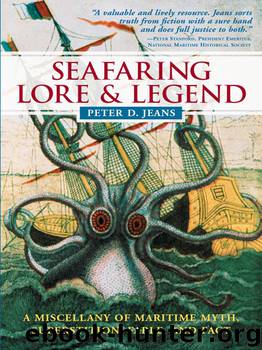Seafaring Lore and Legend by peter d. jeans

Author:peter d. jeans
Language: eng
Format: epub
Published: 2018-10-03T16:00:00+00:00
T HE B ATTLE OF C OPENHAGEN
"Time, off o' Cop'nhaïgn, Nels'n comed an' crep his waïy in—. . .
we worn't n' more 'n skittleses, th' waïy they bowled us over."
S TEEN S TEENSEN B LICHER, "T IME, O FF O' C OP'NHAÏGN"
The island of Zealand (Sjælland) almost completely straddles the entrance to the Baltic Sea from the North Sea; on this island is the Danish port of Copenhagen; between it and Sweden is the Øresund (The Sound). Copenhagen is thus sited in an important strategic position. In Danish the city's name is København, literally "merchant's harbor," from the fact that the locality, ever since it was first occupied some six thousand years ago, has been a trading center for the entire Baltic region.
In 1800 the northern powers of Russia, Prussia (at that time a state in northern Germany), Denmark, and Sweden—all with earnest French backing—formed an armed coalition of mutual defense in answer to British insistence that its navy had the right to search foreign vessels at sea for contraband, for British seamen (those held prisoner as well as those who had deserted the navy), and for whatever else it chose. The British response to this Scandinavian impertinence was, naturally, to send a large fleet of warships—some fifty-three in all, including eighteen line-of-battle ships—to the Baltic early in 1801 in order to teach the locals a salutary lesson in the God-given rights of imperial powers.
In any case, Britain had important trade interests in the Baltic. Because of her difficulties with France during the French Revolutionary Wars and the Napoleonic Wars from about 1793 to 1815, Britain needed to ensure the flow of naval supplies from that northern region (mast timber particularly, tar, and other necessary goods). The former owners of those goods were not to be permitted to interfere with Britain's urgent need of them.
Admiral Sir Hyde Parker was the commander-in-chief (the same who, three years earlier, had been admiral commanding in the West Indies Station when HMS Hermione raised bloody mutiny against Parker's favorite, the altogether unpalatable Captain Hugh Pigot; see HMS Hermione Mutiny, chapter 9). Second in command was Horatio Nelson (see Lord Nelson, chapter 8). Parker's brief was to persuade Denmark to withdraw from the league within twenty-four hours; should Denmark refuse, he was to ensure that her forces were, one way or another, prevented from being brought into play. Denmark declined the offer.
Parker then sent his fleet against the Danish fleet at Copenhagen, with Nelson in command. For their part the Danes put up such a stiff and determined resistance that Parker, fearful of inordinate British losses, signaled Nelson to break off and retreat. Nelson famously feigned ignorance of his chief's signal, asserting, as he put his telescope to his blind eye, that he had a right to be blind sometimes, whereupon he pressed the attack and finally overcame the enemy's defenses by bombarding Copenhagen.
Download
This site does not store any files on its server. We only index and link to content provided by other sites. Please contact the content providers to delete copyright contents if any and email us, we'll remove relevant links or contents immediately.
Sea Survival Handbook by Keith Colwell(1796)
Deep by James Nestor(1789)
Fatal Storm by Rob Mundle(1788)
Breath by James Nestor;(1761)
The River by Peter Heller(1698)
Lonely Planet Australia by Lonely Planet(1676)
Discover Australia by Lonely Planet(1586)
Iced In by Chris Turney(1579)
Lonely Planet Maldives (Travel Guide) by Planet Lonely & Masters Tom(1427)
One Girl One Dream by Dekker Laura(1355)
Ten Degrees of Reckoning: The True Story of a Family's Love and the Will to Survive by Hester Rumberg(1346)
Looking for a Ship by John McPhee(1320)
Lonely Planet Australia (Travel Guide) by Lonely Planet & Lonely Planet(1309)
Chicken Soup for the Ocean Lover's Soul by Jack Canfield(1289)
South with the Sun by Lynne Cox(1222)
The Wave In Pursuit of the Rogues, Freaks and Giants of the Ocean(1217)
Marlinspike Sailor's Arts and Crafts by Barbara Merry(1207)
Diver Down by Michael Ange(1194)
The Golden Rules: 10 Steps to World-Class Excellence in Your Life and Work by Bob Bowman & Charles Butler(1159)
